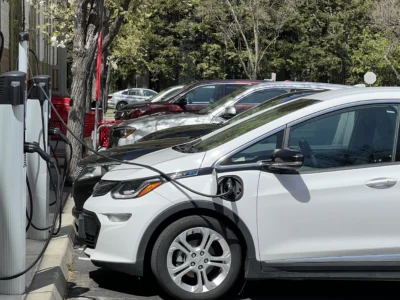California’s Electric Car Culture
Legal Planet: Environmental Law and Policy 2024-09-23

Since the Pavley Act passed in 2002, California has been a leader in cutting greenhouse gas emissions from new cars. Even today, a third of all new U.S. electric vehicles (EVs) are sold in California. Getting here has been the result of a long regulatory process, which helped create a market for companies like Tesla. Achieving California’s ambitious targets will require an exponential increase in EV sales over the next eleven years. In this post, I trace the history of EV efforts and look at what needs to happen now if the state is going to stay on its trajectory.
California’s Evolving EV Policy
1990.
The California Air Resources Board (CARB) adopts first low-emission vehicle regulation, which would have required that 10% of new vehicle sales be zero-emission vehicles (including plug-in hybrids) by 2003. The goal was to eliminate conventional pollutants, not greenhouse gases.
1991-2011.
The technology didn’t advance as quickly as regulators had expected in 1990, although the mandate may have sparked GM’s pathbreaking EV1 car. CARB moved toward hybrids as a way of reducing emissions.
2012
Gov. Brown issues executive order requiring 1.5 million ZEVs in use by 2025.
CARB adopts Advanced Clean Cars I rule requiring that 10% of 2025 cars be ZEVs. This target was met four years early.
1% of new car sales are ZEVs.
2019.
Gov. Brown updates the state’s ZEV goal to 5 million by 2030.
7% of new cars are ZEVs.
2020
Gov. Newsom issues executive order phasing out gas cars by 2035 and heavier trucks by 2045.
CARB adopts Advanced Clean Trucks rule starting transition away from diesel in 2024.
8% of new cars are ZEVs.
2022
CARB adopts Advanced Clean Cars II rule, which requires 100% of new cars sold in 2035 to be ZEVs. [Technically, the standard related to the model year designation of a car, which can begin earlier than the calendar year.]
19% of new cars sold are ZEVs.
2023
25% of California new cars (447,000) are EVs, with 1.5 million total on the road.
2030
Gov. Brown’s target requires that 5 million EVs be on the road.
CARB’s target is for 68% of 2030 model cars be EVs.
2035.
Target date to eliminate sales of new gas cars in California.
Staying on Trajectory.
Gov. Brown’s 2030 target (5 million EVs on the road). The 2030 target is 5 million vehicles on the road. To meet the target, Californians will need increase annual ZEV sales from 447,000 in 2023 to an average of 500,000 per year. That seems eminently doable.
CARB’s 2035 target. CARB is mandating 100% EVS by 2035. To hit this target, California needs to average a 6% annual increase in the percentage of ZEVs in new car sales. CARB is aiming for 35% ZEV sales in 2026. If the increase from 2023 happens smoothly, that would mean 2024 EV sales of about 61,000 cars more than last year. That may be tough in a year where EV demand is softer than expected.